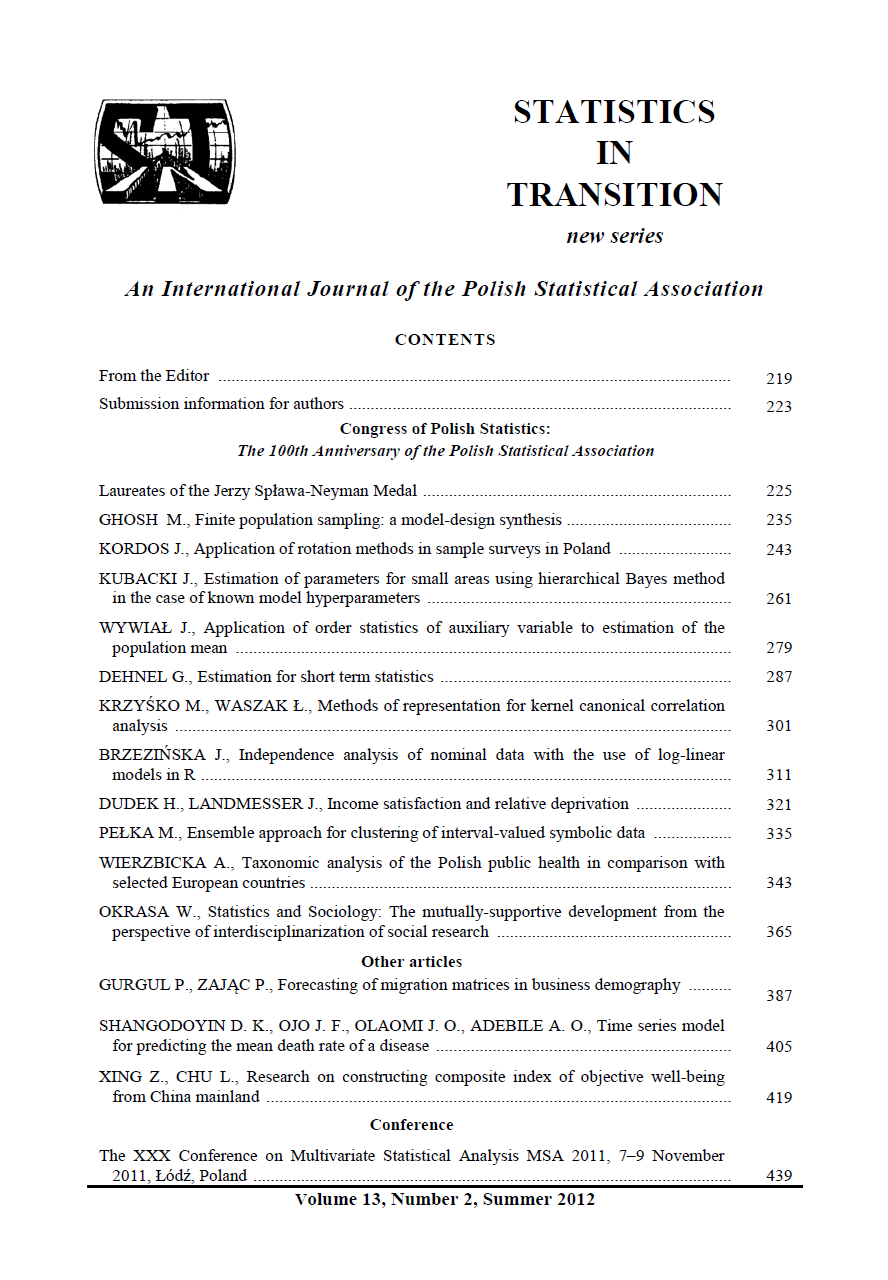ARTICLE
ABSTRACT
Log-linear models are used to analyze the relationship between two or more categorical (e.g. nominal or ordinal) variables. The term log-linear derives from the fact that one can, through logarithmic transformations, restate the problem of analyzing multi-way frequency tables in terms that are very similar to ANOVA. Specifically, one may think of the multi-way frequency table to reflect various main effects and interaction effects that add together in a linear fashion to bring about the observed table of frequencies. There are several types of models between dependence and independence: homogenous association, partial association, conditional association and null model. Expected cell frequencies are obtained with the use of iterative proportional fitting algorithm (IPF) [Deming, Stephen 1940]. The next step is to derive model coefficients for single variables as well as for interaction parameter and the most useful tool for interpreting model parameter is odds and odds ratio. Log-linear models are available in R software with the use of loglm function in MASS library and glm function in stats library. In this paper log-linear analysis will be presented with the use of available packages on empirical datasets in economic area.
KEYWORDS
Log-linear models, cross-tabulation, qualitative data, independence analysis of nominal data
REFERENCES
AGRESTI, A., 2002. Categorical Data Analysis, Wiley & Sons, Hoboken, New Jersey.
AKAIKE, H., 1973. Information theory and an extension of the maximum likelihood principle, in: Proceedings of the 2nd International Symposium on Information, Petrow B. N., Czaki F., Budapest: Akademiai Kiado.
BISHOP, Y. M. M., FIENBERG E. F., HOLLAND P. W., 1975. Discrete Multivariate Analysis, MIT Press, Cambridge, Massachusetts.
CHRISTENSEN, R., 1997. Log-Linear Models and Logistic Regression, Springer–Verlag, New York.
COX, D. R., 1970. Analysis of Binary Data, London, Mathuen.
COX, D. R. and SNELL, E. J., 1984. Applied Statistics, Principles and Examples. Chapman & Hall.
FIENBERG, S., 1980. The analysis of cross-classified categorical data, MIT Press, Cambridge.
FRIENDLY, M., 2000. Visualizing categorical data, SAS Institute Inc.
GREENACRE, M. J., 1993. Correspondence analysis in practice, London Academic Press.
HABERMAN, S. J., 1974. The Analysis of Frequency Data, Chicago, University of Chicago Press.
HORNIK, K., MAYER D., ZEILEIS A., 2006. The strucplot framework: visualizing multi-way contingency tables with vcd, Journal of Statistical Software, 17 (3), 1-48.
ISHII-KUNTS, M., 1994. Ordinal log-linear models, Sage University Papers.
KNOKE, D., BURKE P. J., 1980. Log–linear Models, Quantitative Applications in the Social Science” 20, Sage University Papers, Sage Publications, Newbury Park, London, New Delhi.
LINDSEY, J. K., 1973. Inferences from Sociological Survey Data: A Unified Approach, New York, Elsevier.
MADSEN, M., 1976. Statistical analysis of multiple contingency tables. Two examples. Scand. J. Statist. 3, 97–106.
PEARSON, K., 1900. On a criterion that a given system of deviations from the probable in the case of a correlated system of variables is such that it can be reasonably supposed to have arisen from random sampling, Philos. Mag. Ser. 5, 50, 157-175.
PLACKETT, R. L., 1974. The Analysis of Categorical Data, London, Griffin.
RAFTERY, A. E., 1986. A note on Bayesan Factors for log-linear contingency table models with vague prior information, Journal of the Royal Statistical Society, Ser. B, 48, 249-250.
YULE, G. U., 1900. On the association of attributes in statistics, Phil. Trans. Ser. Q 194, 257-319.
